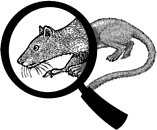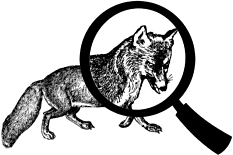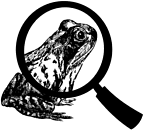The Book of Animal Ignorance (14 page)
Read The Book of Animal Ignorance Online
Authors: Ted Dewan
T
he fossa (
Cryptoprocta ferox
) is only found on Madagascar, where it is the top land carnivore. It's the size of a spaniel, looks like a cat, but is distantly related to the mongoose. Imagine a cross between a puma and a giant otter that leaps through the branches like a squirrel and you're close. Its name is a Malagasy word, pronounced âFOO-sa'.
Among many odd things about fossa, one remains completely unexplained and unique. The young females start to grow a penis. Actually, it's a big clitoris, but it has a bone in it and is covered in the same vicious looking backward-facing spines as the male appendage. They leak the bright orange discharge of a sexually mature adult male and develop genital bumps that look like testes. Odder still, when they reach maturity at four years old, all this stops and the clitoris shrinks back to normal size.
Quite why the young fossa females want to look like males baffles zoologists. It isn't accompanied by a surge in male hormones, or aggression, as in hyenas. Maybe it's just to keep the boys away until they are ready to mate.
THE DOG-CAT-MONGOOSE THAT
LIVES IN A TREE
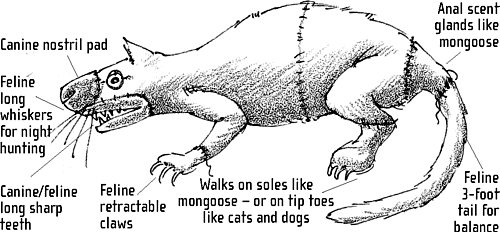
A brief examination of their mating habits tends to confirm this. A female in heat will climb to the top of a tree, while at its
foot a pack of males gather, making threatening calls and getting into ferocious fights. The female will mate with several males over the course of a week, before another female climbs the tree to take her place. Each copulation lasts up to three hours, punctuated by licking, biting and yowling as they somehow manage to stay in the branches. The spiny male penis locks them rear to rear, like dogs.
The fossa's Latin name
, Cryptoprocta ferox,
means âferocious hidden
anus' â because a pouch
covers the anus and
contains glands that it
uses to mark its
territory
.
Genetic evidence suggests that the eight Malagasy carnivores are all descended from a single species of mongoose that âblew in' from African thirty million years ago. That makes fossa a direct relative of the common ancestor of cats and dogs, which is certainly how they look.
They are ferocious hunters, and although they don't actually attack cattle they will take on large female lemurs, consuming everything: fur, bones, and claws. They will also kill snakes, rodents, fish and birds. Their biggest threat, predictably, is the human destruction of their environment. Since their arrival a mere 1,500 years ago, humans have cleared 95 per cent of the forests that covered the island.
Madagascan people have a deep fear of fossa, partly owing to the folk memories of a recently extinct fossa relative which was the size of a tiger. Malagasy parents scare their children with tales of them stealing babies, or killing all the chickens in a coop with their terrible flatulence.
Zoologists estimate there are 2,500 fossa left, but can't be certain. They are masters of concealment: some researchers who have studied lemurs for years have never seen a fossa.
T
he red fox (
Vulpes vulpes
) is easily the most widespread and abundant wild carnivore on earth. Foxes are astonishingly adaptable and are found almost everywhere in the world, from deserts to the Arctic Circle. But unlike many of its close relatives, including the wolf, the fox is in no danger of being persecuted out of existence: it is the ultimate opportunist and has learnt to live alongside humans, without sacrificing any of its feral integrity.
In Japan, foxes are
sacred to the Shinto
religion and âfox
possession' is a
recognised clinical
condition. Symptoms
include a craving for
rice and an inability to
make eye contact
.
Despite this, the number of urban foxes isn't increasing âexponentially'; in most Western cities the population reached its maximum supportable size years ago, and the count of surviving cubs each year is almost identical to the number of deaths. The fox population explosion, like almost everything people think they know about urban foxes, is an urban myth. Even the term itself is inaccurate: âurban' foxes are mostly suburban â they don't like city centres but prefer areas of low-density, semi-detached housing with big gardens, which is why Britain has so many (North American suburbs have raccoons instead).
Urban foxes are just as healthy as country foxes; the town is, if anything, a better environment for them than the countryside. They don't live âmainly' by scavenging from bins. Foxes will eat literally almost anything: it's what makes them so successful. Their regular diet includes earthworms, insects, moth larvae, pigeons, rodents, beetles and plenty of fruit and veg. In the autumn, they can practically live on apples, blackberries and rosehips.

They don't âhunt in packs' or kill cats. Foxes live in small family groups, but always hunt alone. They would never attack a domestic cat or dog unless cornered (although they've been
known to try their luck with swans). Nor do they massacre chickens âfor fun'. Foxes are cache-hunters: they will take as many animals as they can, and then bury the carcasses one by one in a âlarder' for later. The reason they leave dead chickens behind in the coop is that they are disturbed on one of their many trips to and from the larder.
Most of the nuisance caused by foxes is far outweighed by their indispensable role as rodent-killers. Even the deeply annoying habit of digging up lawns and sports fields is not entirely their fault, as they mistake the smell of blood-and-bone fertiliser on the grass for dead meat, and try to uncover a non-existent corpse. On the other hand, don't encourage them to nest under your house. At night, the noise of the cubs screaming as they fight and play is indescribable, almost as bad as the smell of carrion, urine and faeces (the latter will be cheerfully deposited as a âmark' on any shoes or children's toys you leave outside). They also enjoy chewing through electricity and phone wires, and gas and water pipes.
MOUSE DIVING
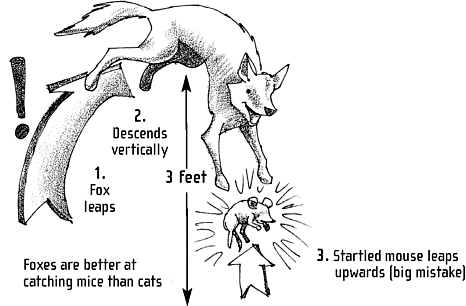
Urban foxes can easily become tame, even allowing themselves to be fed from the hand and stroked like a pet. This latent tameness was selectively bred in a famous Russian experiment of the 1950s. Within twenty years, the foxes had lost all fear of humans, wagged their tails, developed floppy ears and black and white fur: they had become, in effect, âdogs'.
I
n fairy-tales, frogs are ugly but kind; in real life, they are breathtakingly lovely and deadly dangerous. Such is true, at least, of the brilliantly coloured tree frogs of South America. Their neon reds, shocking oranges, acid greens, purples and blues cover the entire visible spectrum and their eyes are like precious stones.
The world's deadliest frog is the Golden poison dart frog,
Phyllobates terribilis
. Sometimes mint-green, sometimes Kodak yellow, it is no larger than a bottle-top but contains enough toxins to kill 20,000 mice or ten men. An amount of its poison weighing less than three grains of salt is sufficient to kill a person and even just to hold one in your hand can be lethal. Poison dart frogs are so called because tribesmen use their venom to tip the missiles of their blowpipes. Captain James Cochrane first discovered this in 1823. He also found out how they extracted the poison: skewering the frog so painfully that it sweated it out. The second most poisonous frog in the world is the Black-legged dart frog (
Phyllobates bicolor
) of Colombia. It is bright orange or yellow with navy-blue legs. The locals make this one sweat by heating it over a flame.
To vomit, some frog
species cough up
their whole
stomach and then
carefully rinse it
out with their right
hand before
pushing it back
inside
.
FROGGY GOES
A-COURTIN'
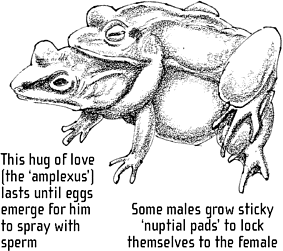
As a general rule, the more beautiful the frog, the more dangerous it is. This is called aposematism, from the Greek for âwarning sign'. The tiny, red-and-white-striped Ecuadorean tree frog,
Epipedobates tricolor
, seems to be wearing a Sunderland FC strip or impersonating a barber's pole. Comical? Certainly not: it will kill you. Other species aren't dangerous but have evolved to look as if they are. The Red-eyed tree frog of Costa Rica is green with blue-and-yellow striped sides, orange toes and liquid scarlet
eyes. It has a call that sounds like a baby rattlesnake but it is completely harmless. This is called Batesian mimicry after Henry Walter Bates (1825â92) who spent seven years in the Amazon with Alfred Russell Wallace and found 8,000 creatures new to science.
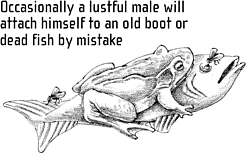
Trinidad's Paradoxical frog (
Pseudis paradoxa
) is so called because its tadpoles are three times larger than the adult, but frogs and paradoxes go hand in hand. There are over 5,000 known species and new ones turn up all the time â a hundred in Sri Lanka in 2002 alone. But they're also dying out at an alarming rate: a third of all frogs are at risk, because frogs breathe through their skin. Though their toxins can occasionally be dangerous to us, the poisons that humans leave lying around are far deadlier to them. This may be a tragedy for both of us. Frog toxins are alkaloids â like cocaine, nicotine, codeine, caffeine and quinine â and scientists are finding that these beautiful paradoxes are living medicine chests, whose deadly poisons can be transformed into drugs that may cure everything from cancer to Alzheimer's disease.
Epipedobates tricolor
yields a painkiller 200 times more powerful than morphine;
Phyllobates terribilis
provides another 600 times as powerful. Both are non-addictive, with no side effects. Inside other frogs may be muscle relaxants and heart stimulants, and cures for strokes, bacterial infections and depression. There is a prince in there, after all.
